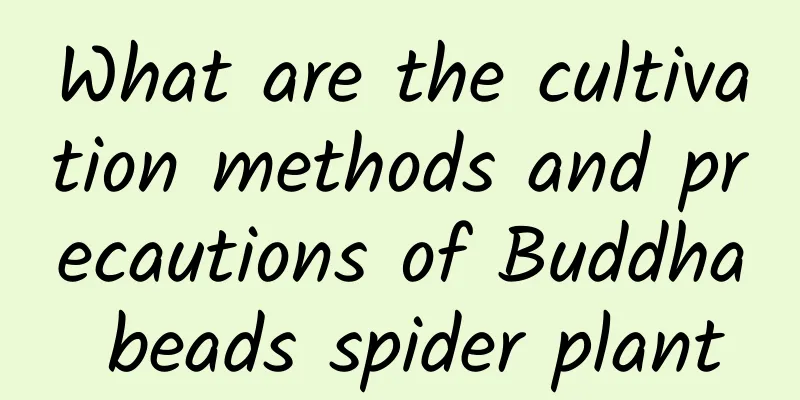What are the cultivation methods and precautions of Buddha beads spider plant

Introduction of Chlorophytum comosumThe Buddha Bead Plant is a plant of the genus Senecio of the Asteraceae family, also known as the Emerald Bead Plant. Its leaves are round and thick, heart-shaped, dark green in color, very much like beads, hence the name Buddha beads, Buddha beads, green grapes, and green bells. The Buddha Bead Plant is propagated by cuttings. How to grow Chlorophytum comosumThe soil for the spider plant can be prepared by mixing leaf mold or peat soil, garden soil and river sand, and adding a small amount of base fertilizer. Repot it every 2-3 years. Its fleshy roots are highly resistant to drought, but it requires a lot of water during the peak growth period from March to September. The soil needs to be kept moist and sprayed moderately to increase humidity. Watering should be reduced after autumn to improve the plant's resistance to cold. The Buddha's Pearl Plant prefers a semi-shady environment and should be placed in a cool, ventilated place with good light. If the potting soil is waterlogged and the ventilation is poor, root rot will occur, and you should pay attention to spraying pesticides for prevention and control. Watering methodThe Buddha's Beaded Chlorophytum is a relatively drought-resistant plant and should not be overwatered. The principle of watering is to keep it dry rather than wet. Generally speaking, water it every 3-5 days in summer and once every half a month in winter and spring to avoid excessive moisture or drought in the potting soil. Fertilization methodThe Buddha's Beaded Spider Plant grows vigorously in spring and autumn, and its demand for fertilizer is relatively large at this time. Fertilization should be carried out according to the principle of applying small amounts of fertilizer frequently. Nitrogen fertilizer or potassium dihydrogen phosphate can be sprayed on the leaves. The leaves will become green and the ornamental effect will be better. No fertilizer is needed in summer and winter, otherwise fertilizer damage will occur. Precautions for growing spider plantsYou need to be careful when caring for the Buddha's Pearl Plant in summer. The temperature is high at this time. If you water it too much, it is most likely to cause the stems of the Buddha's Pearl Plant to rot. It is best to spray water to keep it moist. The light intensity is relatively high at this time, so it should not be exposed to the sun. It needs to be moved to a semi-shaded place indoors and ventilated frequently. |
<<: What are the cultivation methods and precautions for potted roses?
>>: What are the breeding methods and precautions for flamingoes?
Recommend
Breeding methods and precautions of water hyacinth
How to cultivate water hyacinth temperature Water...
Why is Ginkgo biloba and Metasequoia called living fossils?
1. What is a living fossil? Living fossils are or...
The planting method and time of mugwort. Which month is the best for planting?
Suitable time for planting mugwort Mugwort is a v...
When is the best time to repot Daphne odora? Time and precautions for repotting soil
Time to repot Daphne odora Daphne osmanthus needs...
How many roots of lucky bamboo are best to grow in soil
1. Two (1) Reason: It is mainly explained based o...
Complete picture of ornamental vegetable varieties The latest varieties of vegetables with high ornamental value
With the development of society, many vegetables ...
Where do pistachios grow?
Pistachios are relatively large and oblong in sha...
Pomegranate cutting time and method
Pomegranate cutting time Pomegranate cuttings are...
Precautions for rose repotting in summer Specific steps for changing the soil and repotting roses (complete)
Things to note when changing rose pots in summer ...
Maple leaves benefits and functions
Maple leaves benefits and functions Medicinal Alt...
Why are the leaves of chrysanthemums turning yellow?
1. Unsuitable soil Reason: Chrysanthemums grow be...
Is pumpkin a fruit or a vegetable?
Is pumpkin a fruit or a vegetable? Pumpkin is a k...
Breeding methods and precautions of Qingshengjin
1. Maintenance methods 1. Temperature: It has rel...
Can Jade Dew be exposed to the sun? Is it okay without sunlight?
Can Jade Dew be exposed to the sun? Jade plant ca...
Should I cut off the pitcher plant cage when it withers? Where should I cut it off?
1. Do withered cages need to be cut off? Generall...









